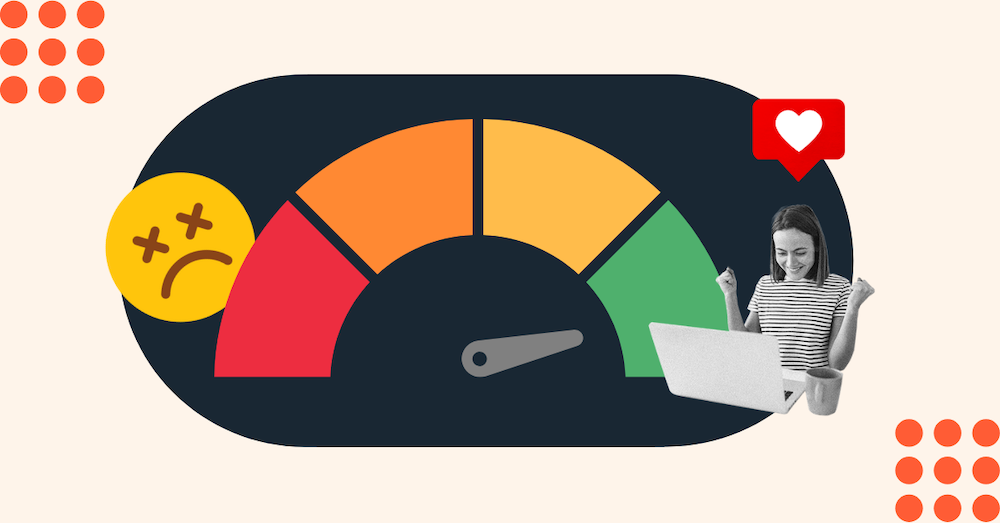Purpose of Customer Satisfaction Survey
Customer satisfaction surveys track how delighted your customers are with your company or an experience with your company. You can use results to measure customer satisfaction score (CSAT), which typically lies on a scale of 1-10.
Analyzing customer responses to questions and CSATs can help you calculate how customer satisfaction has changed over time and how you can make changes to improve the customer experience.
However, there are several mistakes you can make in your surveys that can make your results unhelpful and make it challenging for your customers to give accurate responses or understand what you’re asking them.
Below we’ll discuss common customer satisfaction survey mistakes so you can ensure your survey is as effective as possible.
Customer Satisfaction Survey Mistakes to Avoid
1. You don't clearly define the goal of the survey.
Once you decide you want to issue a customer satisfaction survey, it can be easy to jump right into drafting questions. However, take a step back and consider why you are creating this survey in the first place. Any good researcher knows that the first step in a research process is to select a research question that guides the entire survey.
For example, maybe you want to know why your subscriptions have decreased this month or why customer interactions have increased on social media. Whatever the case, finding the reason behind your survey ensures every question you create will help you understand your purpose.
2. You include too few or too many open-ended questions.
Open-ended questions are challenging because they can’t be quickly analyzed by a survey tool as you have to sit and read through them. On the other hand, open-ended questions leave room for customers to give more in-depth information about a question if they want to.
Either way, an open-ended question provides insight into your customer’s minds, so it’s important to find a balance if you use them. Decide how many open-ended questions to include that won’t cause you to get overwhelmed by reading customer responses.
3. You forget to analyze customer demographics.
Customer satisfaction questions are important, but it’s equally as important to understand your target customer base. The first few questions of your customer satisfaction survey can ask about demographics (age, gender, occupation, etc.) to help you get a better sense of who your target market is.
It’s a best practice to add options for “Prefer not to say” and “Other,” with additional room for explanation to make sure customers have the opportunity to share as much or as little as they want to share.
4. Your questions are too vague.
What's the difference between "How was your experience with us?" and "How would you rate your interactions with our customer service and support teams?" The former is vague, while the latter is much more in-depth. Each question you ask is an essential aspect of your research and should be crafted to pull the most accurate response out of each customer.
Vague questions are, frankly, a waste of your time and your customers' time. You aren't going to garner any interesting finds. By focusing closely on your research question, you can design questions that direct customers in the right direction and ensure that your data is as precise as possible.
5. Your questions can't be quickly analyzed for tangible results.
A common mistake that can lead to inaccurate or incomplete data is choosing questions that have multiple parts. For example, a question like “How would you rate your experience buying from us, and would you recommend us to others?” asks too much in one question and also doesn't allow you to receive responses for both questions.
To avoid this error and make your survey data easy to analyze, ensure that your questions only ask one question.
6. Your survey is too short or long.
Your survey length can make or break your research as longer surveys may overwhelm respondents and make them drop off before completion. In addition, having a lot of questions also adds additional time to your analysis.
On the other hand, a short survey can also be ineffective if you don’t ask enough questions to make profitable observations. If you’re going to invest the time to design a survey, you want it to be as resourceful as possible. Find a solid harmony and create a survey that won’t bore your customers but will still help you answer your research question.
7. Your questions include a bias.
You want your customers to gush over their amazing experiences with you, but you want that to be the truth in their own words. For example, asking, “How great is it when your customer support rep answers your question in under 10 minutes?” is a leading question that can prime the customer into thinking immediate customer support is a positive thing.
Instead, you can phrase that question as, “How important would you rate immediate customer support?” This lets the customer determine their response based on their desires rather than falling under pressure to say what your company wants to hear.
8. Your questions make assumptions about the participants.
You never want to make assumptions about your participants as it can be offensive and cause backlash.
Some examples include assuming specific pronouns and assuming that all customers have a shared experience. While they may not all offend, they can negatively influence your data if, for example, you ask a question about an experience with customer support, but not all of your participants have gotten support.
Take these scenarios into account and leave room for "N/A" options.
9. You force your customers to take the survey.
It’s natural for you to want to send customer satisfaction surveys in your newsletters, share it on your website and social media, and publish it on your blog. However, customers don’t want to be hounded to fill out your survey, which can drive them away. Instead, you have to accept that some — or even many — of your customers won’t fill out your survey, no matter how easy it is to do so.
You’ll likely find more success by gently reminding customers to take the survey and explaining that it will help you improve their customer experience in the future.
10. You make assumptions about the larger population based on a sample that is too small or non-diverse.
It’s a red flag to assume that a sample's opinions accurately represent the entire regional, national, or global consumer population.
No matter how many people take your survey, whether five or 500,000, you have to clarify that the results are based on your survey respondents. Also, be clear that, while your research findings are interesting and valuable, they can’t predict what everyone believes.
11. You don't create change based on the survey results.
Finally, the most significant mistake you can make is doing nothing with your data, as the point of conducting a customer satisfaction survey is to learn both what your customers enjoy about your company and what they don’t.
Learning what has bothered or upset them about your company allows you to reevaluate and adapt that part of your customer process. Learning what leaves customers delighted and excited tells you what you’re doing right and should continue doing and helps you discover things to mention in your marketing materials that may attract new customers.
Let’s go over some examples of bad survey questions you can use as a strategy for what not to do.
Bad Survey Questions
1. How awesome was the product?
Asking how awesome a product was is a leading question that assumes the customer enjoyed the product or service. Instead, you can ask, “How would you rate this product?”
Respondents can answer the question on a Likert scale, with 1 being ineffective at solving my problems and 5 being effective at solving my problems.
2. How likely are you to recommend our product to a friend or colleague if she asks about it?
Asking a question that uses an assumed pronoun is biased. Instead, you can ask, “How likely are you to recommend our product to a friend or colleague?”
3. Did you find our product helpful, and did it meet your expectations?
Asking a double-barreled question doesn’t let respondents give you valuable feedback on both questions.
You can separate this double-barreled question into two questions and ask, “Did you find our product useful?” and “Did our product meet your expectations?”
4. Do you like when your support rep answers your question in under five minutes?
Asking a leading question like this assumes that customers are getting support from your business in under five minutes and that they appreciate fast service.
Instead, you can ask, “How important would you rate immediate customer support?” to get concrete insight into customer preferences.
5. The onboarding process made it easy for me to get started. Answer scale: 1 (strongly disagree) - 5 (Agree)
A question using a Likert scale like this confuses respondents because the scale isn’t logical on. Instead, you can use an answer scale with 1 being strongly disagree and 5 being strongly agree.
6. The website was hard for me to use.
A leading question like this assumes a customer's experience and doesn’t give you the complete picture of their experience.
Instead, you could ask, “Rate your experience navigating the website on a scale of 1 (extremely challenging) to 5 (extremely easy).”
7. When choosing a product, I look for ease of use.
This leading question again assumes a customer's experience and purpose with your business.
A question that gives you more actionable responses is “What features are important to you when choosing a product?” with a list of corresponding features they can choose from.
While the information and questions above are specific to customer satisfaction surveys, you can apply the section below to any of your customer feedback forms or questionnaires.
Other Common Survey Mistakes
12. You overlook typos and grammatical mistakes.
Some form builders don’t have spelling and grammar checking software that reviews and corrects your copy. If you’re not careful, you can publish spelling and grammatical mistakes that can confuse your participants and even be embarrassing.
Run through your surveys two or three times and make sure it’s perfect.
13. You rush your survey to publication.
All businesses have deadlines to ensure projects are completed on time. For teams working against the clock, it’s important to prioritize quality over efficiency because rushing a survey into publication and releasing one with mistakes only leads to more work in the future.
For instance, if you forget to include an answer to a multiple-choice question, the data you obtain will be inaccurate. Some participants may also be confused by your selection of answers, which could cause them to abandon the survey altogether.
Unless timing is urgent, it's better to slow down and create an effective, complete survey than rush one into production.
14. You forget to include a question or an answer.
Another simple mistake is forgetting to include a question in your survey, as each question increases your chances of obtaining information and learning more about your customer base.
Additionally, forgetting to include answers is equally as harmful because you just won’t get results for that question. If you have too many missed questions or answers, you risk having your survey look disorganized and frustrating customers that eventually drop off.
15. You use the wrong delivery method.
Even if your survey is perfect, it's all for not if you use the wrong channels to distribute.
The right delivery method depends on your survey and your customer journey map. If you're publishing a customer satisfaction survey, you'll want to choose a moment after a notable customer experience to launch your survey. If you're trying to collect information on customer demographics, then you may want to spring your survey towards the beginning of the customer journey.
16. You use complicated or technical language.
Part of making your survey user-friendly is using familiar language that makes sense to the participant. If your survey questions include complicated business jargon, participants won't know what you're asking them.
Instead, stick to simple, casual language that anyone can understand. After all, you want your participants to be comfortable and feel like the survey-taking process is smooth and efficient.
Editor's note: This post was originally published May 2020 and has been updated for comprehensiveness.
Customer Satisfaction
.png?width=112&height=112&name=Image%20Hackathon%20%E2%80%93%20Horizontal%20(24).png)



![Big Brands That Lost Customers' Satisfaction [Where CX Went Wrong + Data]](https://53.fs1.hubspotusercontent-na1.net/hubfs/53/companies%20that%20lost%20customers_featured.png)


![23 Excellent Customer Satisfaction Survey Examples [+ Templates]](https://53.fs1.hubspotusercontent-na1.net/hubfs/53/customer-satisfaction-survey-example_0.webp)




![How To Design Customer Satisfaction Surveys That Get Results [+ Templates]](https://53.fs1.hubspotusercontent-na1.net/hubfs/53/customersatisfactionsurvey.webp)